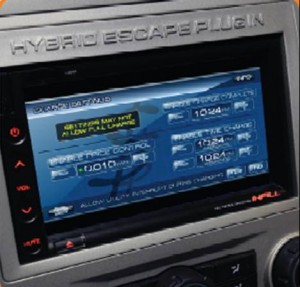
By John Addison (11/11/09)
Smart Grid EV Charge
By 2020, 219,000 customers of PG&E may say goodbye to those trips to the gas station. No more spinning dials at the pump – $20.00, $40.00, $80.00, etc. Instead drivers will conveniently plug-in their electric cars at home or work. The fill-up will be electrons, not gasoline.
Across the country, electric utilities are preparing to offer smart charging boxes for the garage and charging stations for work and downtown locations. For a fraction of gasoline cost, you will be able to charge plug-in vehicles.
Pacific Gas and Electric (PG&E), for example, is a utility that is planning to service between 219,000 and 845,000 battery electric cars and plug-in hybrids by 2020, under three different planning scenarios presented at Greentech’s The Networked Grid Conference. PG&E currently provides electricity to 5 million customers, including a few thousand that currently drive electric cars. Currently, most of these electric cars are 25-mile per hour neighborhood vehicles that are popular in college and university towns. A few hundred can zoom past you on a freeway, such as the Tesla Roadster.
This year, Newsweek ranked PG&E as the greenest utility in the country due to its strong commitment to customer energy efficiency programs and renewable energy (RE) programs. PG&E serves 15 million people in northern and central California with 123,054 miles electric distribution lines needed to cover 70,000 square miles of its service area. Natural gas is 46 percent of PG&E’s source for electricity, nuclear 20 percent, hydro 16 percent, and out-of-state coal only 2 percent.
Renewable Energy > Coal + Natural Gas by 2020
Renewable energy is 14 percent of PG&E’s total delivered electricity today. It will miss its legal requirement to be at 20 percent by the end of 2010 due to NIMBY roadblocks to large solar thermal plants in the desert. PG&E needs approvals to install the high-voltage lines necessary to bring utility-scale RE to PG&E customers, thereby adding to its current 18,610 circuit miles of interconnected transmission lines.
Hal LaFlash, PG&E Director of Emerging Clean Technologies, outlined how the utility will have 34.8 TWh of RE in 2010 and 77.6TWh of RE in 2020, the year when California utilities must generate 33 percent of their electricity from RE. By 2020, renewable energy may be the utility’s #1 source of energy. The RE mix will be (1) solar thermal, (2) photovoltaics, (3) wind, (4) geothermal, with bioenergy and ocean adding to the total.
With terawatts of nighttime wind power, PG&E may have more electricity at night than it needs. One million electric vehicles could easily be supported provided that they charge off-peak, preferably at night. Smart charging allows customers to plug-in; yet not have charging begin until a preferred time, such as when excess electricity is available to the grid. PG&E hopes to secure regulatory approval for time-of-use pricing so that customers have an incentive to charge at night.
Utility executives worry that people will charge whenever they feel like it. Since charging an electric car is like powering an entire home, the concern is valid. People are still buying gas guzzlers as pump prices rise, so they many may ignore price incentives to charge at night. So far, early customers of plug-in vehicles have been environmentally concerned, and have shown a preference for charging with renewables including their own solar rooftops. Automakers, utilities, and regulators are working to make it easy for new electric car customers to select night time and even renewable energy charging through web browsers, smart phones, and even vehicle dash displays.
Smart Charging and Renewable Energy
Between the electric cars and renewable energy will be a smart grid. Every vehicle charging device will include a smart meter. PG&E is leading the nation with 1.6 million smart meters now installed. It is installing an average of 13,000 per day, and will have 10 million smart meters installed by 2012.
Andrew Tang, PG&E Senior Director of the Smart Energy Web, expects 35 different models of plug-in vehicles to be available within the next two years. PG&E actively meets with auto makers to make sure that smart charging networking is compatible and in place. Only some homes and communities are now ready with dedicated 240V/30A circuits for the 4-hour charging that electric car leaders, such as Nissan recommend.
Although smart charging provides for two-way communication, electricity will only be delivered one-way from the grid to the vehicle. Mr. Tang expressed skepticism about vehicle-to-grid (V2G) being cost-effective and acceptable to customers and automakers, even though PG&E has done V2G demonstrations within its own fleet, with Tesla, with Google, and elsewhere. PG&E is looking at MW grid storage alternatives such as pumped hydro and compressed air, such as the 300MW compressed air storage in Kern Country that PG&E has applied for a federal grant. Sulfur Sodium batteries that could scale to hundreds of MW were also presented at the conference.
Infrastructure issues may be greatest in communities that are now adopting hybrid cars at fast rates. For example, in Berkeley, 18 percent of new car sales are hybrids. As electric cars sell briskly in some communities, PG&E will likely need to upgrade substations to handle the increased distribution of electricity.
With the advanced planning outlined in PG&E’s presentations and with regulatory support for time-of-use pricing, renewable energy, and high-voltage lines, PG&E will be ready to power a new generation of vehicles for a fraction of the cost of gasoline. Increasingly, these electric cars will be powered by solar, wind, and other renewables.
